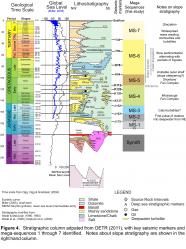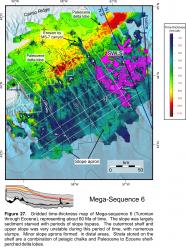Mega-sequence 6 (MS-6) – Turonian to Late Eocene (duration ~ 60 Ma)
Mega-sequence 6 (MS-6) – Turonian to Late Eocene (duration ~ 60 Ma)
Like MS-5, MS-6 is thickest above the shelf, with very thin equivalent strata on the slope (Fig. 27). The lower boundary of MS-6 corresponds to the K94 marker located near the base of the chalky Petrel Member. Its upper boundary is a merger between shelf markers defining the top of the Eocene succession and a slope marker that corresponds to the top Eocene T35 marker described by Deptuck and Campbell (2012). MS-6 therefore includes the upper part of the Dawson Canyon Formation, Wyandot Formation, and the lowermost part of the Banquereau Formation (Wade and MacLean, 1990; Fig. 4).
The thickest parts of MS-6 generally correspond to Paleocene deltas perched on the shelf. They are offset landward and to the east relative to the thickest parts of MS-5. Seismic reflections on the shelf consist of low-angle prograding clinoforms that alternate with higher amplitude continuous but commonly faulted seismic reflections. The latter commonly correspond to pelagic chalks of the Petrel Member, Wyandot Formation, Acadia chalk, or other unnamed Paleocene chalks (Wade and MacLean, 1990; Fensome et al., 2008). Well data indicates that the topset of shelf clinoform packages are sandy, with well-developed up-ward coarsening log motifs (e.g. Sachem, D-76). Foresets are generally muddy.
MS-6 thins across the outer shelf towards the older shelf edge established during MS-5. Numerous northeast-trending normal faults offset MS-6 here (Fig. 26). Further seaward, slope deposits are thin but highly complex, containing numerous unconformities and abundant evidence for slope failures and shallow detachment faults that sole out in the lower parts of MS-6 or the upper parts of MS-5. These are particularly common immediately seaward of shelf-edge trajectory 6 (Fig. 26) defining the seaward limit of MS-5 progradation. Wade et al. (1995) showed that numerous unconformities are present in this interval on the eastern Scotian Shelf, and several of them merge and are indistinguishable on the slope. Significant erosion is recorded across the MS-5 and MS-6 boundary, and it was not until the Late Eocene that any appreciable amounts of strata finally accumulated above the K94 marker on the slope. These deposits strongly resemble time-equivalent Unit 1 of Campbell (2011) and sub-units 1a, 1b, and 1c of Deptuck and Campbell (2012) on the western Scotian margin, which record multiple periods of slope failure. The reader is directed to these sources for a more detailed account of these deposits.




